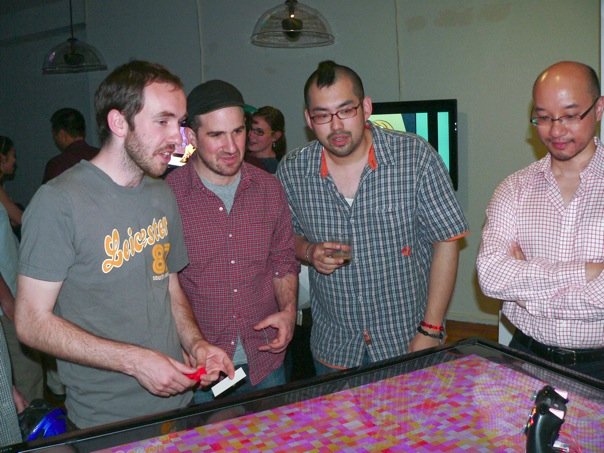Nana, my MFADT thesis, is a non-player game built with a modified video game console and a repurposed game controller. The project reduces the role of human players to mere spectators and explores the interplay between machines. Nana, the name of the little robot, is a curious video game controller with a mobile sub-unit. She rolls on a flat LCD screen and communicates the information she found on the colorful screen to the game console (The Mother). The Mother reads the information and turns them into various direct and indirect outputs, mostly in the forms of sound and visual. Once a while, when the information sequence is matching certain condition that is agreed between Mother and Nana, Mother will turn the screen off. Nana will then take a rest, and a random bedtime story about Nana will be narrated by Mother before everything goes back to normal.
I didn’t come to DT to be a creative technologist, but like most of my peers, I was seeking a change in my design career. After I took all the necessary steps and figured out how to built a Simon Says electronic game in the physical computing (pcomp) class, it was clear that interactive electronics is the change I was looking for. That being said, I started late, I didn’t dive into the world of physical computing right in the beginning, so when I entered my thesis year, I was still taking pcomp themed courses. Every Time I am introduced to a new possibility, I will change a part of my thesis if not all of it, that drives my thesis teacher nuts. I tried to catch up and get ahead. Eventually, I landed on the idea of Mother and Nana, an expandable and interconnected system that can grow with my newly gained knowledge.
I created a circuit to read the voltage sent to the vibration motors in the game controller. The strength of the voltage is controlled by API in XNA. Therefore, I can create my own protocol to map the strength of the voltage to a set of commands in my microcontroller (BS2). For input to the XNA, I use the analogue stick(s), it is made of two potentiometers with about 10K resistance each. In XNA, the resistance will be mapped to a number between -1 and 1.
I had a lot of fun hacking Xbox 360 controllers, especially making the slave mobile sub-unit. It is made of two modules, a motor module and secondary communication module (SCM). The motor module came straight from an old toy of mine, it has two sets of geared motors well intergraded together in a metal structure. SCM is slightly complicated. It is made of an Atari 2600 cartridge PCB, a BASIC Stamp 2 (BS2), a motor driver, and a set of two optoisolators. When I designed this chassis I decided to look back to early video game hardware for inspirations. I have been using the Atari 2600 cartridge PCB for some of my BS2 projects in the past. The PCB has exactly the same number of pins as a BS2 chip. I usually mount my BS2 on a PCB, and use it with a regular Atari 2600 connector, it looks really nice on top of a robot.
https://makezine.com/2008/05/30/parsons-design-technology-1/
